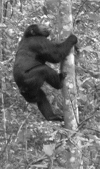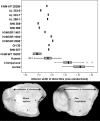Functional morphology of the ankle and the likelihood of climbing in early hominins
- PMID: 19365068
- PMCID: PMC2672491
- DOI: 10.1073/pnas.0900270106
Functional morphology of the ankle and the likelihood of climbing in early hominins
Abstract
Whether early hominins were adept tree climbers is unclear. Although some researchers have argued that bipedality maladapts the hominin skeleton for climbing, others have argued that early hominin fossils display an amalgamation of features consistent with both locomotor strategies. Although chimpanzees have featured prominently in these arguments, there are no published data on the kinematics of climbing in wild chimpanzees. Without these biomechanical data describing how chimpanzees actually climb trees, identifying correlates of climbing in modern ape skeletons is difficult, thereby limiting accurate interpretations of the hominin fossil record. Here, the first kinematic data on vertical climbing in wild chimpanzees are presented. These data are used to identify skeletal correlates of climbing in the ankle joint of the African apes to more accurately interpret hominin distal tibiae and tali. This study finds that chimpanzees engage in an extraordinary range of foot dorsiflexion and inversion during vertical climbing bouts. Two skeletal correlates of modern ape-like vertical climbing are identified in the ankle joint and related to positions of dorsiflexion and foot inversion. A study of the 14 distal tibiae and 15 tali identified and published as hominins from 4.12 to 1.53 million years ago finds that the ankles of early hominins were poorly adapted for modern ape-like vertical climbing bouts. This study concludes that if hominins included tree climbing as part of their locomotor repertoire, then they were performing this activity in a manner decidedly unlike modern chimpanzees.
Conflict of interest statement
The author declares no conflict of interest.
Figures




Similar articles
-
Tree climbing and human evolution.Proc Natl Acad Sci U S A. 2013 Jan 22;110(4):1237-42. doi: 10.1073/pnas.1208717110. Epub 2012 Dec 31. Proc Natl Acad Sci U S A. 2013. PMID: 23277565 Free PMC article.
-
Phenotypic plasticity of climbing-related traits in the ankle joint of great apes and rainforest hunter-gatherers.Hum Biol. 2013 Feb-Jun;85(1-3):309-28. doi: 10.3378/027.085.0315. Hum Biol. 2013. PMID: 24297231
-
Chimpanzee ankle and foot joint kinematics: Arboreal versus terrestrial locomotion.Am J Phys Anthropol. 2017 Sep;164(1):131-147. doi: 10.1002/ajpa.23262. Epub 2017 Jun 8. Am J Phys Anthropol. 2017. PMID: 28594068
-
Locomotion and posture from the common hominoid ancestor to fully modern hominins, with special reference to the last common panin/hominin ancestor.J Anat. 2008 Apr;212(4):501-43. doi: 10.1111/j.1469-7580.2008.00870.x. J Anat. 2008. PMID: 18380868 Free PMC article. Review.
-
Spinopelvic pathways to bipedality: why no hominids ever relied on a bent-hip-bent-knee gait.Philos Trans R Soc Lond B Biol Sci. 2010 Oct 27;365(1556):3289-99. doi: 10.1098/rstb.2010.0112. Philos Trans R Soc Lond B Biol Sci. 2010. PMID: 20855303 Free PMC article. Review.
Cited by
-
Trabecular Architecture of the Proximal Tibia in Extant Hominids.Am J Biol Anthropol. 2025 Jul;187(3):e70084. doi: 10.1002/ajpa.70084. Am J Biol Anthropol. 2025. PMID: 40583737 Free PMC article.
-
Biomechanics of Climbing Coconut Trees and its Implications in Ankle Foot Morphology- A Video Sequence analysis.J Clin Diagn Res. 2013 May;7(5):790-3. doi: 10.7860/JCDR/2013/4397.2959. Epub 2013 May 1. J Clin Diagn Res. 2013. PMID: 23814711 Free PMC article.
-
A new hominin foot from Ethiopia shows multiple Pliocene bipedal adaptations.Nature. 2012 Mar 28;483(7391):565-9. doi: 10.1038/nature10922. Nature. 2012. PMID: 22460901
-
The African ape-like foot of Ardipithecus ramidus and its implications for the origin of bipedalism.Elife. 2019 Apr 30;8:e44433. doi: 10.7554/eLife.44433. Elife. 2019. PMID: 31038121 Free PMC article.
-
Commemorating the monkey bars, catalyst of debate at the intersection of human evolutionary biology and public health.Evol Med Public Health. 2024 Aug 19;12(1):143-155. doi: 10.1093/emph/eoae017. eCollection 2024. Evol Med Public Health. 2024. PMID: 39282242 Free PMC article. Review.
References
-
- Leakey MG, Feibel CS, McDougall I, Walker A. New four-million-year-old hominid species from Kanapoi and Allia Bay, Kenya. Nature. 1995;376:565–571. - PubMed
-
- Ward CV, Leakey MG, Walker A. Morphology of Australopithecus anamensis from Kanapoi and Allia Bay, Kenya. J Hum Evol. 2001;41:255–368. - PubMed
-
- Haile-Selassie Y. Late Miocene hominids from the Middle Awash, Ethiopia. Nature. 2001;412:178–181. - PubMed
-
- Pickford M, Senut B, Gommery D, Treil J. Bipedalism in Orrorin tugenensis revealed by its femora. CR Palevol. 2002;1:191–203.
-
- Richmond BG, Jungers WL. Orrorin tugenensis femoral morphology and the evolution of hominin bipedalism. Science. 2008;319:162–1665. - PubMed
Publication types
MeSH terms
LinkOut - more resources
Full Text Sources
Research Materials
Miscellaneous

